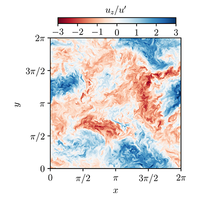大涡模拟中的人工瓶颈效应
IF 2.5
3区 物理与天体物理
Q2 PHYSICS, FLUIDS & PLASMAS
引用次数: 0
摘要
在纳维-斯托克斯(Navier-Stokes)湍流中,粘滞截止附近的能量级联中的瓶颈效应会导致相对于科莫戈罗夫(Komogorov)-5/3幂律比例的能谱过冲(或称谱凸)。在使用涡流粘度模型进行大涡模拟(LES)时,也会出现类似的频谱过冲现象。这不是一种粘性现象,而是由于残余应力模型的误差造成的。LES 中的这种人为瓶颈效应会导致对动能的过度预测,即使使用了可靠的动态程序来准确捕捉截止长度尺度处的频谱衰减。最近,Johnson [J. Fluid Mech. 934, A30 (2022)]介绍了一种受物理学启发的空间滤波概念广义化方法,它提供了一种无需测试滤波计算的动态程序。在本文中,这种斯托克斯流正则化(SFR)方法与动能相关的基本因素一起用于生成一系列 LES 模型,以更详细地探索人工瓶颈效应。每个动态模型的系数都是局部确定的,无需对均质方向进行平均。该理论直接提供了稳定要素,如系数的局部平均。报告对各向同性湍流中的模型进行了后验,证明了基于 SFR 的动态程序对一系列模型形式的稳健性,并为公平比较它们对瓶颈效应的影响提供了框架。缓解瓶颈效应的有效方法是在残余应力闭合中引入非线性梯度成分,形成动态混合模型。这种方法之所以有效,一个主要原因是非线性梯度模型能够准确捕捉残余应力的局部结构,从而更好地反映能量级联效率。本文章由计算机程序翻译,如有差异,请以英文原文为准。

Artificial bottleneck effect in large eddy simulations
In Navier-Stokes turbulence, a bottleneck effect in the energy cascade near the viscous cutoff causes an overshoot in the energy spectrum, or spectral bump, relative to Komogorov's −5/3 power-law scaling. A similar spectral overshoot occurs in large-eddy simulations (LES) when an eddy viscosity model is used. It is not a viscous phenomenon, but rather is caused by error in the residual stress model. This artificial bottleneck effect in LES leads to an over-prediction of kinetic energy even if a reliable dynamic procedure is used to accurately capture the spectral decay at the cutoff length scale. Recently, Johnson [J. Fluid Mech. 934, A30 (2022)] introduced a physics-inspired generalization of the concept of spatial filtering that provides a dynamic procedure that does not require a test filter calculation. In this paper, this method of Stokes flow regularization (SFR) is used alongside fundamental considerations related to kinetic energy to generate a range of LES models to explore the artificial bottleneck effect in more detail. The coefficients for each dynamic model are determined locally, without the need of averaging over homogeneous directions. The theory directly provides stabilizing elements such as local averaging of coefficients. A posteriori tests of the models in isotropic turbulence are reported, demonstrating the robustness of the SFR-based dynamic procedure for a range of model forms and providing a framework for fair comparisons between them in terms of their impact on the bottleneck effect. An effective means of mitigating the bottleneck effect is to introduce a nonlinear gradient component in the residual stress closure, forming a dynamic mixed model. One primary reason for the efficacy of this approach is that the nonlinear gradient model is able to accurately capture aspects of the local structure of the residual stresses, leading to a better representation of energy cascade efficiencies.
求助全文
通过发布文献求助,成功后即可免费获取论文全文。
去求助
来源期刊

Physical Review Fluids
Chemical Engineering-Fluid Flow and Transfer Processes
CiteScore
5.10
自引率
11.10%
发文量
488
期刊介绍:
Physical Review Fluids is APS’s newest online-only journal dedicated to publishing innovative research that will significantly advance the fundamental understanding of fluid dynamics. Physical Review Fluids expands the scope of the APS journals to include additional areas of fluid dynamics research, complements the existing Physical Review collection, and maintains the same quality and reputation that authors and subscribers expect from APS. The journal is published with the endorsement of the APS Division of Fluid Dynamics.
 求助内容:
求助内容: 应助结果提醒方式:
应助结果提醒方式:


